Buying Guides
Toilet Height Comparison: Standard Vs. Comfort for a Comfortable Bathroom
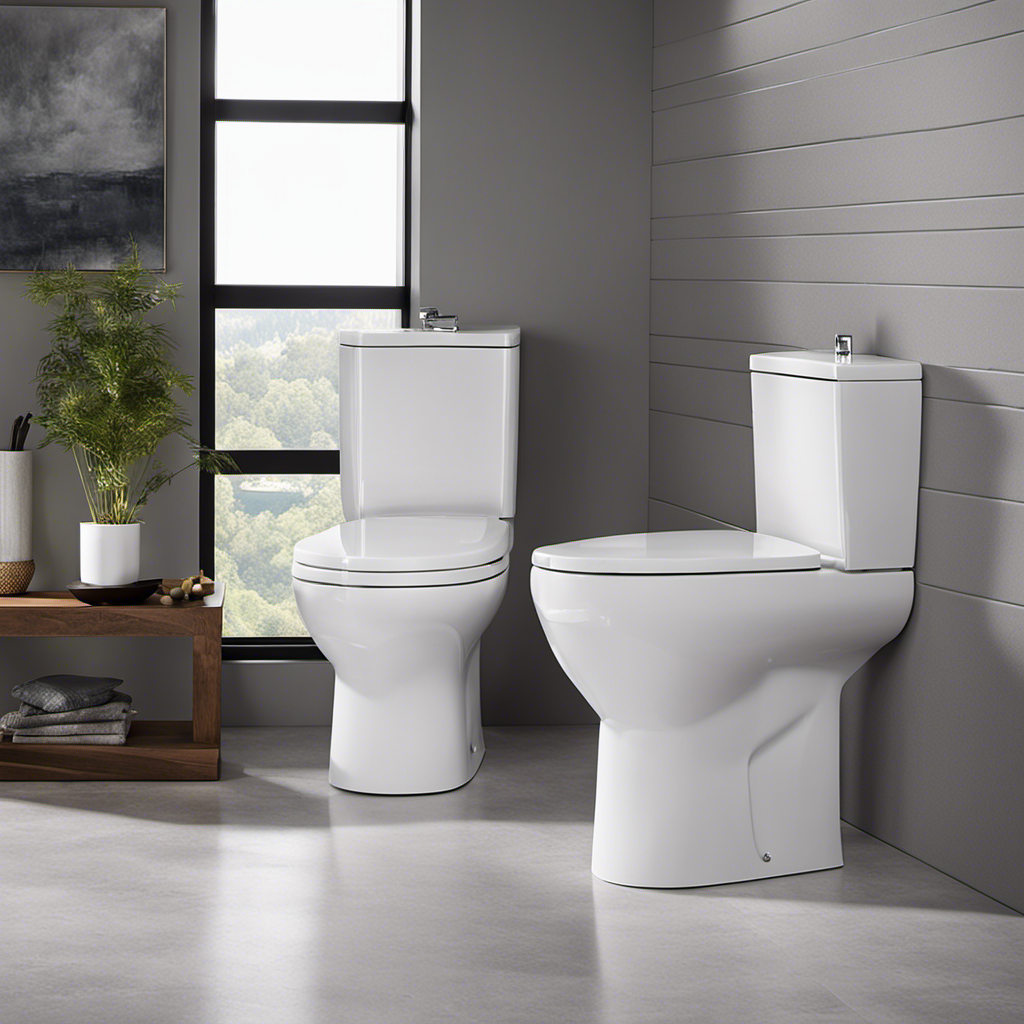
I remember the time when I renovated my bathroom and had to choose between a standard height toilet and a comfort height toilet. It seemed like a small decision, but it turned out to make a big difference in terms of comfort and usability.
Standard height toilets are great for shorter individuals, like children, but for taller folks like myself, comfort height toilets provide a much-needed relief for the knees.
In this article, we will explore the differences between standard and comfort height toilets and help you make an informed decision for a more comfortable bathroom.
Key Takeaways
- Standard height toilets are the most common type in the US and may be more suitable for shorter individuals.
- Comfort height toilets have a higher seat off the ground, ranging from 17 to 19 inches, and are designed for easier sitting and standing for taller individuals and those with disabilities.
- Comfort height toilets alleviate pressure on the knees and are recommended for individuals over about 54 inches.
- Toilet preferences depend on the user’s needs, budget, and aesthetic preferences, but it’s important to consider the needs of guests and family members who may require special accommodations.
The Difference in Height: Standard Vs. Comfort Toilets
I prefer comfort height toilets because they are higher off the ground compared to standard height toilets, making it easier for me to sit and stand up from.
Comfort height toilets provide several benefits, including considerations for children and health benefits for seniors. For children, standard height toilets may be more suitable due to their shorter stature. However, comfort height toilets can still be used by children with the help of a step stool.
Additionally, comfort height toilets offer health benefits for seniors. The higher seat height reduces the strain on their knees and joints, making it easier for them to sit down and stand up. This can be especially beneficial for individuals with mobility issues or arthritis.
Overall, comfort height toilets are a practical and accessible option for individuals of all ages.
Considerations for Shorter Individuals
For shorter individuals, it’s important to consider a toilet that allows for easier and more comfortable use. Here are four advantages of standard height toilets:
-
Accessibility for children: Standard height toilets are often more suitable for children, as they provide a comfortable seating position for little ones. This can make potty training and bathroom visits much easier for them.
-
Cost-effective option: Standard height toilets are the most common type available in the market, which means they are generally more affordable compared to comfort height toilets. This can be beneficial for individuals on a budget.
-
Easy maintenance: Standard height toilets are easier to clean and maintain due to their simpler design. There are no additional components or mechanisms to worry about, making it a convenient choice for shorter individuals.
-
Familiarity and availability: Since standard height toilets are the most common type used in households, they are readily available in a wide range of styles and brands. This allows for more options when selecting a toilet that matches the overall aesthetic of your bathroom.
Benefits of Comfort Height Toilets for Taller Individuals
The increased seat height of comfort height toilets provides a more convenient and ergonomic experience for taller individuals. As someone who is taller, I have personally experienced the benefits of using a comfort height toilet.
The higher seat allows for a more natural sitting and standing position, reducing strain on the knees and back. This is especially important for individuals with disabilities who may have difficulty bending or have limited mobility.
Additionally, the impact on the bathroom experience of others cannot be overlooked. By having comfort height toilets in your home, you are providing a more inclusive and accessible environment for all individuals.
It ensures that everyone, regardless of their height or physical abilities, can comfortably and safely use the bathroom.
Accessibility and Ease of Use: Comfort Height Toilets
Installing a comfort height toilet ensures that individuals with disabilities or limited mobility can easily and safely use the restroom. Here are some important points to consider regarding installation requirements and cost comparison:
-
Installation Requirements:
- Comfort height toilets have the same installation requirements as standard height toilets.
- They can be installed using a standard rough-in measurement of 12 inches from the wall to the center of the drain.
-
Cost Comparison:
- In terms of installation costs, comfort height toilets are generally the same as standard height toilets.
- However, some comfort height toilets may be slightly less expensive than standard height toilets, depending on the brand and model.
Aesthetic Options: Finding the Right Fit for Your Bathroom
When choosing a toilet, I want to find an option that complements the aesthetic of my bathroom. Aesthetics vs. functionality is an important consideration when customizing your bathroom. You want a toilet that not only looks good but also performs well. To help you make an informed decision, I have created a table comparing the two main types of toilets: standard height and comfort height.
| Type of Toilet | Height (inches) | Suitable for |
|---|---|---|
| Standard Height | 15-16 | Shorter individuals, like children |
| Comfort Height | 17-19 | Taller individuals, those with disabilities |
Both types have their advantages, so it ultimately depends on your specific needs. Many brands offer both standard height and comfort height options, allowing you to find a unit that matches your bathroom’s aesthetic without compromising on comfort. Consider the needs of your household members and aim for a comfortable and safe home environment. Finding the right balance between aesthetics and functionality is key when customizing your bathroom.
Factors to Consider When Choosing Between Standard and Comfort Height Toilets
As I consider which type of toilet to choose, I weigh the factors that will affect my decision.
1) Considerations for children: Standard height toilets may be more suitable for shorter individuals, such as children, as the bowl height is 15 to 16 inches from the floor to the top of the seat.
2) Cost comparison: Installation costs are generally the same for both standard height and comfort height toilets. However, some comfort height toilets may be slightly less expensive than standard height toilets.
3) User preferences: Toilet preferences depend on the user and their specific needs.
4) Accessibility: Comfort height toilets, with a seat height of 17 to 19 inches, are more accessible for taller individuals and those with disabilities.
Ultimately, it’s important to choose the right kind of toilet that fits your budget, aesthetic preferences, and the needs of the bathroom users in your home.
Creating a Comfortable and Safe Bathroom Environment
I prioritize the well-being and safety of my family. One important aspect of creating a comfortable bathroom is adjusting the toilet height for different users. It is crucial to consider the needs of individuals with varying heights and abilities. Standard height toilets may be suitable for shorter individuals, such as children, while comfort height toilets are more accessible for taller individuals and those with disabilities.
Additionally, safety features in bathroom design are of utmost importance. Installing grab bars near the toilet and in the shower area can provide stability and support for individuals with mobility issues. Non-slip flooring and adequate lighting are also essential for preventing accidents.
Frequently Asked Questions
Are Comfort Height Toilets More Expensive Than Standard Height Toilets?
Comfort height toilets are generally more expensive than standard height toilets due to their ergonomic design. However, the cost comparison may vary depending on the brand and model. It’s important to consider budget and individual needs when making a decision.
Can Standard Height Toilets Be More Suitable for Children?
Standard height toilets can be more suitable for children due to their lower bowl height. However, comfort height toilets, with their higher seat, offer benefits to taller individuals and those with disabilities.
Are Comfort Height Toilets Recommended for Individuals With Disabilities?
Yes, comfort height toilets are recommended for individuals with disabilities. The higher seat makes it easier for them to sit and stand up, providing better accessibility. This is one of the benefits of comfort height toilets.
Are There Any Installation Differences Between Standard and Comfort Height Toilets?
When it comes to toilet installation tips, choosing the right toilet height for your needs is important. The installation process for standard and comfort height toilets is generally the same, so it’s more about personal preference and accessibility requirements.
Can the Height of a Toilet Impact the Overall Bathroom Experience?
Yes, the height of a toilet can impact the overall bathroom experience. Comfort height toilets provide ergonomic benefits and improved accessibility, making it easier for taller individuals and those with disabilities to sit and stand up.
Conclusion
In conclusion, when deciding between standard and comfort height toilets, it’s crucial to consider the needs and preferences of the bathroom users.
While standard height toilets are more suitable for shorter individuals, comfort height toilets provide added convenience for taller individuals and those with disabilities.
The choice between the two types should be based on personal preferences, budget, and the safety and comfort of the home environment.
So, whether you’re aiming for a sleek and modern look or a more traditional aesthetic, finding the right fit for your bathroom is essential.
Liam’s journey with us started as a consumer. Having faced challenges while setting up his own modern bathroom, he delved deep into research.
Recognizing his knack for simplifying complex information and his authentic writing style, we were thrilled to welcome him aboard. Liam’s articles often merge practicality with style, ensuring readers find the perfect fit for their homes. Liam is an avid hiker off-duty and often jokes about finding the best “natural toilets” Mother Earth has to offer.
Buying Guides
How Do I Stop My Toilet From Leaking After Flushing

Are you fed up with wrestling with a leaky toilet that appears to have a mind of its own? Don’t worry, we have the solution for you! Follow our detailed instructions to finally resolve this irritating issue.
Just imagine having a toilet that works flawlessly, without any annoying leaks or drips. In this article, we’ll show you exactly how to stop your toilet from leaking after flushing, so you can achieve true mastery over your plumbing.
Let’s get started!
Key Takeaways
- Checking for and fixing a loose flush valve: Turn off the water supply, flush the toilet to drain the tank, examine the flush valve assembly for looseness or damage, tighten the nut securing the flush valve or replace it if necessary.
- Replacing a faulty flapper: Turn off the water supply, remove the tank lid and flush the toilet to drain the water, disconnect the chain from the flush lever, remove the old flapper, install the new flapper and reconnect the chain.
- Adjusting the water level in the tank: Locate the water level adjustment screw or float adjustment clip, turn the screw clockwise to decrease the water level or counterclockwise to increase it, flush the toilet and observe the water level, make adjustments until the water level is about 1 inch below the top of the overflow tube, test the toilet by flushing it multiple times to ensure no leaks and consistent water level.
- Sealing leaks around the base of the toilet: Inspect the wax ring for cracks or wear, turn off the water supply and remove the toilet, replace the wax ring with a new one, reinstall the toilet and tighten the bolts evenly, test for leaks by turning on the water supply and flushing the toilet.
Common Causes of Toilet Leaks
One of the most common causes of toilet leaks is a faulty wax ring. Identifying hidden leaks is crucial in order to prevent further damage and water wastage. To do this, start by checking for any signs of water pooling around the base of the toilet or a persistent dampness on the floor.
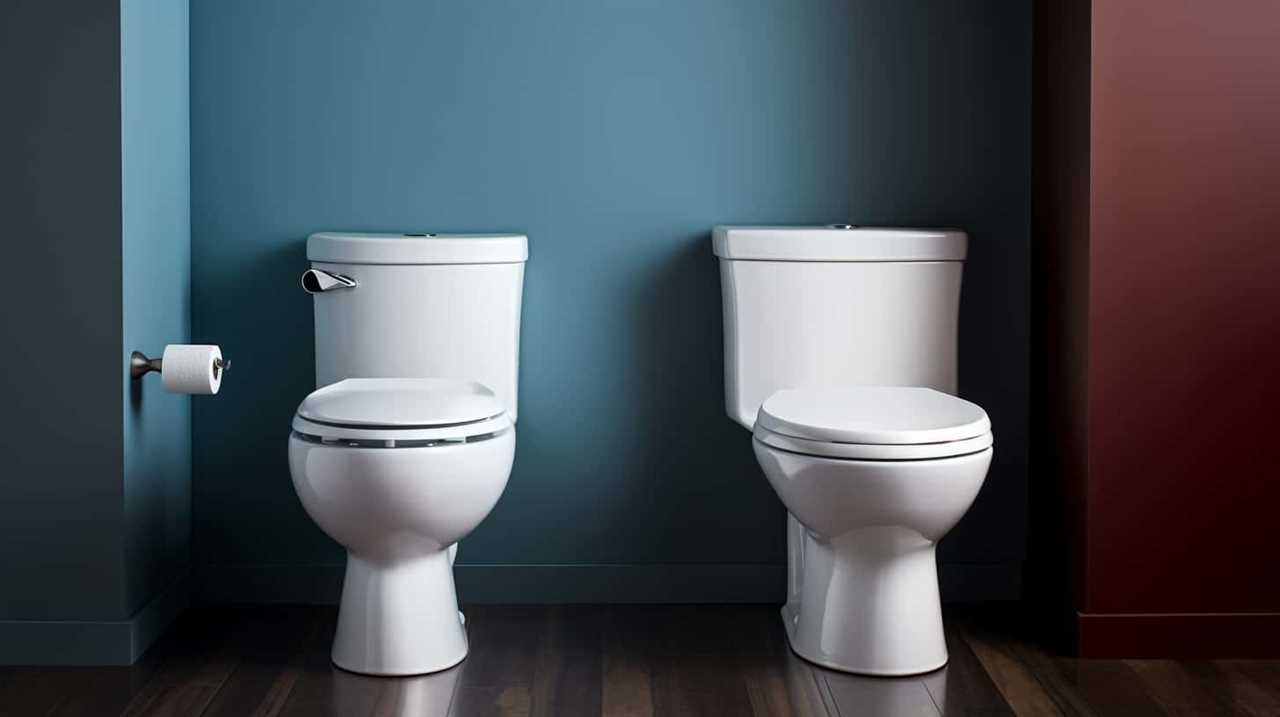
If you suspect a hidden leak, you can also add a few drops of food coloring to the toilet tank and wait for a few minutes. If the water in the bowl changes color without flushing, it indicates a leak.
When it comes to repairs, you might consider DIY options if you have the necessary skills and tools. However, for complex issues or if you’re unsure, it’s best to hire a professional plumber who can provide expert advice and ensure a proper fix.
Checking for and Fixing a Loose Flush Valve
To check for and fix a loose flush valve, we’ll need to inspect the toilet tank for any signs of movement or instability. Here’s how to troubleshoot and replace a flush valve:
- Turn off the water supply to the toilet by shutting off the valve located near the base.
- Flush the toilet to drain the water from the tank.
- Remove the tank lid and place it in a safe spot.
- Examine the flush valve assembly for any visible signs of looseness or damage.
- If the flush valve is loose, use an adjustable wrench to tighten the nut securing it to the bottom of the tank. Ensure it’s snug but not overly tight.
- If tightening the nut doesn’t solve the issue, it may be necessary to replace the flush valve. Consult the manufacturer’s instructions or seek professional assistance for guidance on replacing the flush valve.
Replacing a Faulty Flapper
After checking for and fixing a loose flush valve, the next step in addressing a toilet leak after flushing is to replace a faulty flapper. Troubleshooting flapper issues is crucial in maintaining a leak-free toilet. A faulty flapper can cause water to continuously flow from the tank to the bowl, resulting in wastage and potential water damage.
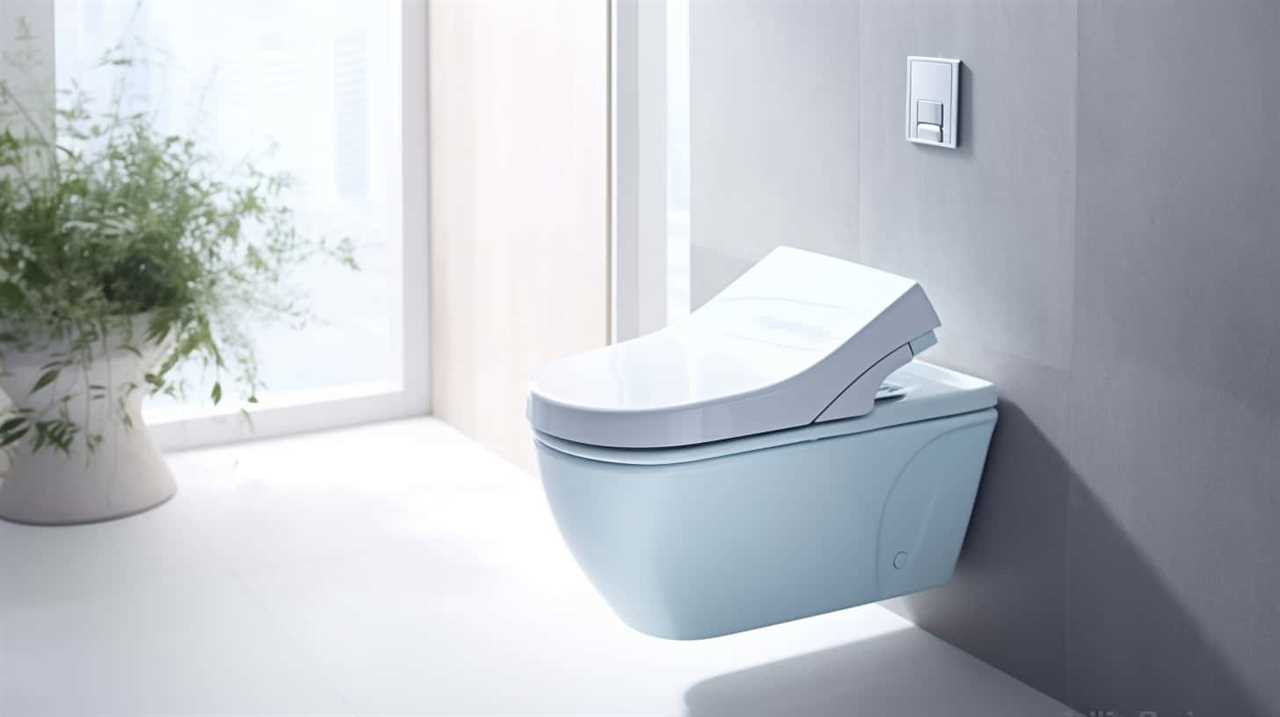
To replace the flapper, first, turn off the water supply to the toilet. Remove the tank lid and flush the toilet to drain the water. Disconnect the chain from the flush lever and remove the old flapper. Install the new flapper by attaching it to the flush valve opening and reconnect the chain. Finally, turn on the water supply and observe if the leak has been resolved.
Regular flapper maintenance is essential in preventing future leaks and ensuring the proper functioning of the toilet. Now, let’s move on to the next step – adjusting the water level in the tank.
Adjusting the Water Level in the Tank
Now, let’s address the water level in the tank to further prevent any potential leaks. Adjusting the water level in the tank is an important step in troubleshooting toilet tank leaks. By ensuring that the water level is set correctly, you can prevent overflow and reduce the risk of leaks. Here are some water level adjustment tips to follow:
| Step | Procedure |
|---|---|
| 1 | Locate the water level adjustment screw or float adjustment clip. |
| 2 | If using a screw, turn it clockwise to decrease the water level or counterclockwise to increase it. If using a clip, move it up or down accordingly. |
| 3 | Flush the toilet and observe the water level. Make adjustments as needed until the water level is about 1 inch below the top of the overflow tube. |
| 4 | Test the toilet by flushing it multiple times to ensure there are no leaks and that the water level remains consistent. |
Sealing Leaks Around the Base of the Toilet
Once the water level in the tank has been adjusted, it’s important to address any leaks around the base of the toilet. Here are some steps to help you seal those leaks and prevent further damage:

- Inspect the wax ring: The wax ring is located between the toilet base and the flange. If it’s cracked or worn out, it needs to be replaced.
- Prepare for replacement: Turn off the water supply to the toilet and flush to remove any remaining water. Remove the toilet by disconnecting the water supply line and unscrewing the bolts securing it to the floor.
- Replace the wax ring: Carefully remove the old wax ring and replace it with a new one. Make sure it’s centered on the flange and press it down firmly.
- Reinstall the toilet: Carefully lower the toilet onto the wax ring, ensuring that the bolts align with the holes on the base. Tighten the bolts evenly and reconnect the water supply line.
- Test for leaks: Turn on the water supply and flush the toilet. Check around the base for any signs of leaks. If there are no leaks, you have successfully sealed the toilet.
Frequently Asked Questions
How Do I Fix a Leaking Toilet Handle?
To fix a leaking toilet handle, first turn off the water supply valve. Remove the lid and locate the handle assembly. Tighten any loose screws or bolts. If that doesn’t work, consider replacing the handle and following the troubleshooting steps for leaking toilets.
Why Does My Toilet Only Leak After I Flush?
Toilet leaks after flushing are often caused by common plumbing issues. Identifying the root cause and addressing it step-by-step is key to stopping the leak. Let’s explore the possible reasons and solutions.
Can I Use a Temporary Fix to Stop the Toilet From Leaking Until I Can Get It Repaired?
If your toilet is leaking after flushing, you can try a temporary fix until you can get it repaired. Start by turning off the water supply, then replace the flapper or adjust the fill valve.
What Should I Do if My Toilet Continues to Leak After I Have Replaced the Flapper?
If our toilet continues to leak after replacing the flapper, we should check the water supply valve. Shutting it off and removing the tank lid, we can inspect the flush valve and make any necessary adjustments or replacements.
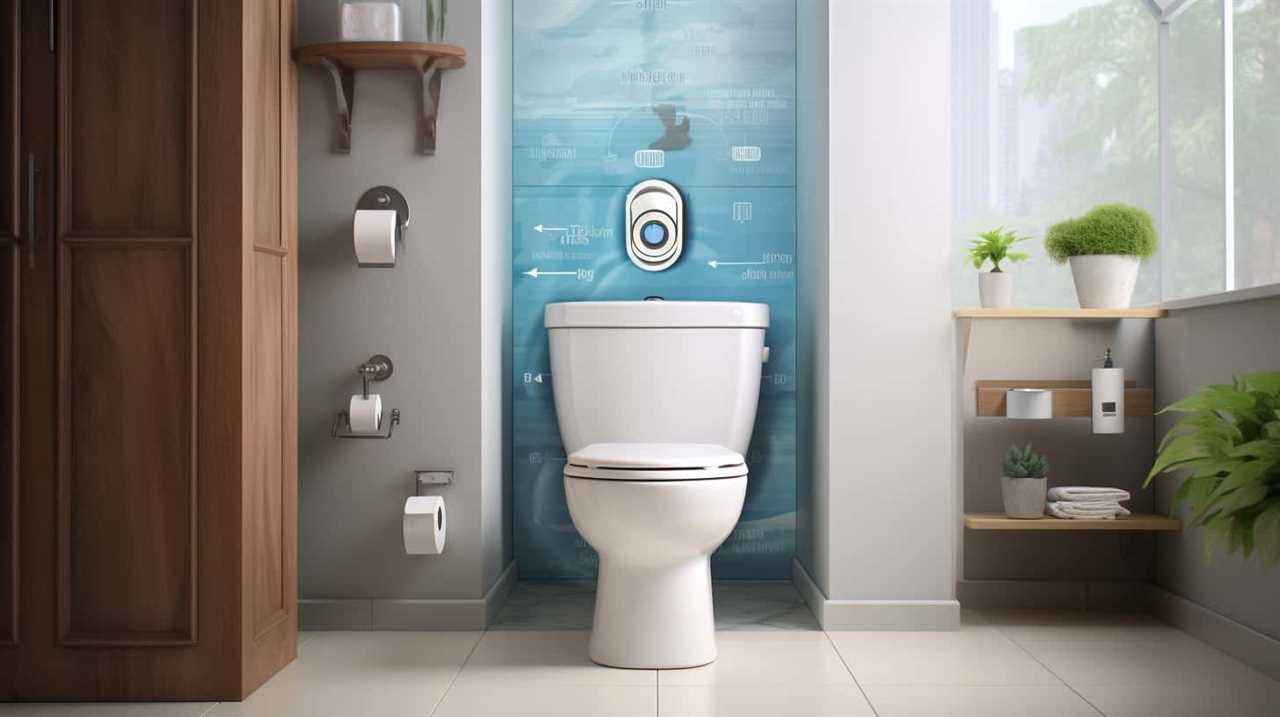
Are There Any Long-Term Solutions for Preventing Toilet Leaks?
Toilet leak prevention is crucial for effective toilet maintenance. By implementing a few long-term solutions, such as regular inspections, replacing worn-out parts, and ensuring proper water pressure, we can minimize the chances of leaks occurring after flushing.
Conclusion
In conclusion, by following these simple steps, you can put an end to the pesky issue of a leaking toilet after flushing.
With a little bit of effort and some basic tools, you can easily fix a loose flush valve, replace a faulty flapper, adjust the water level in the tank, and seal any leaks around the base of the toilet.
Soon, you’ll have a leak-free toilet that functions flawlessly.
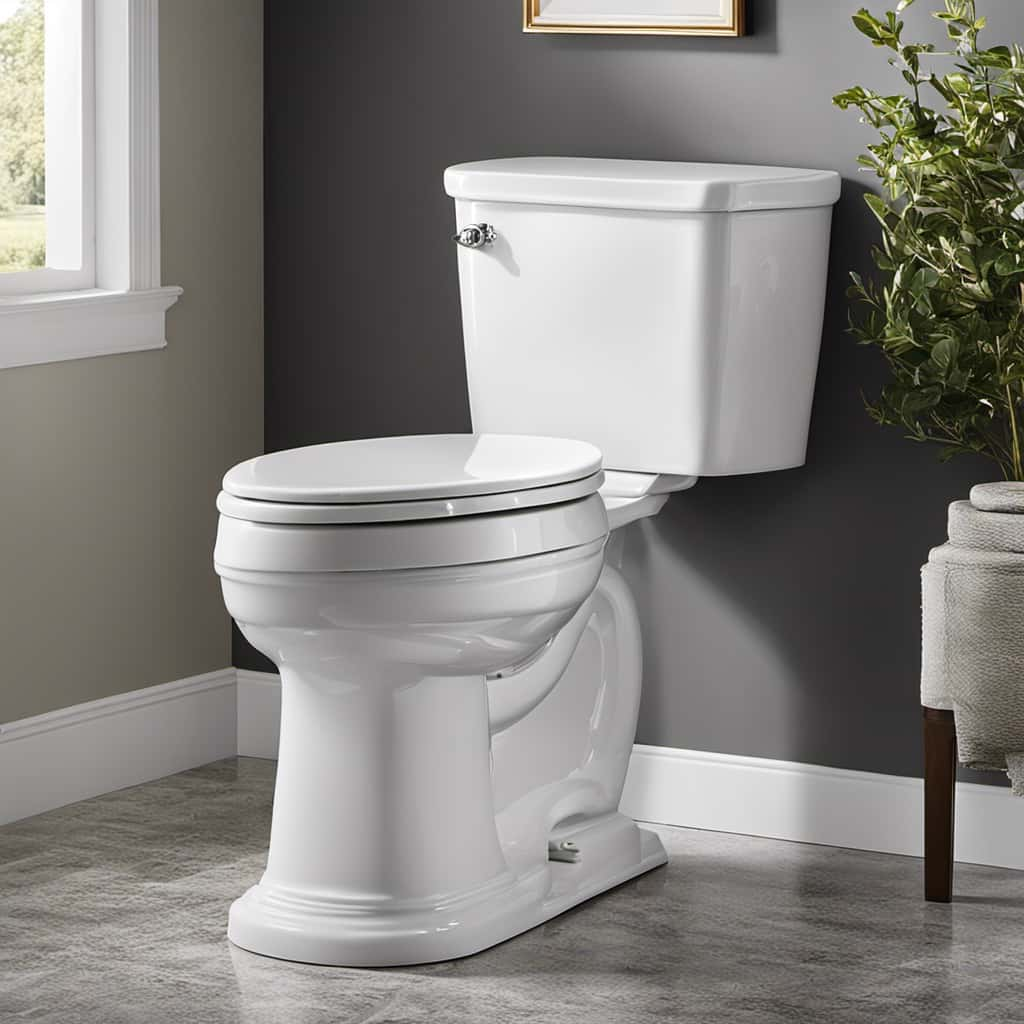
So, don’t let those leaks dampen your day, take action and enjoy a hassle-free bathroom experience!
With an impeccable eye for detail and a passion for bathroom-related, Ava leads our editorial team gracefully and precisely.
Under her guidance, Best Modern Toilet has flourished as the go-to resource for modern bathroom enthusiasts. In her free time, you might find Ava exploring antique shops and looking for vintage bathroom fixtures to add to her collection.
Buying Guides
Where Does Toilet Paper Go After Being Flushed
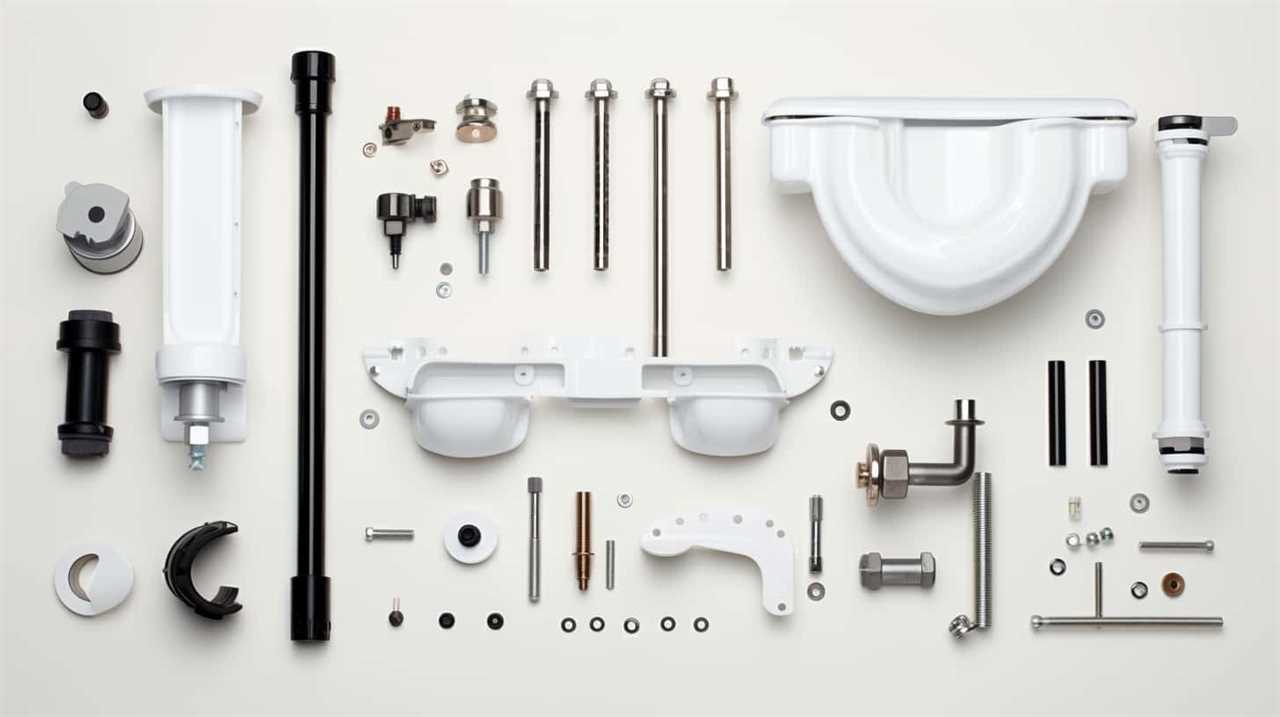
We, the inquisitive minds, set out on a mission to uncover the mysterious journey of toilet paper after it is flushed.
Join us as we navigate the labyrinth of pipes and witness the awe-inspiring treatment process.
With precision and expertise, we explore how this humble necessity breaks down and filters through the system.
Prepare to be enlightened about the final destination of our flushing efforts, whether it be disposal or the possibility of a second life.
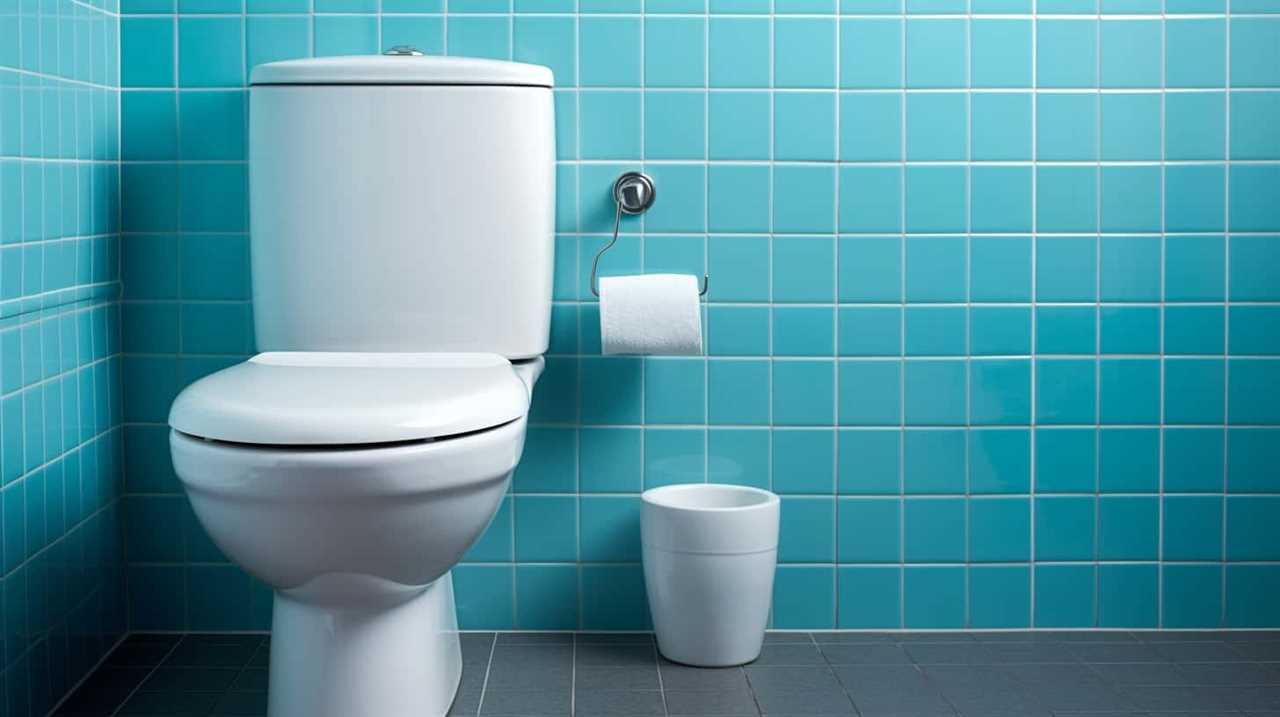
Let us delve into the depths of toilet paper’s mysterious voyage.
Key Takeaways
- Flushing toilet paper can lead to clogs and blockages in the plumbing system, disrupting its functionality and causing environmental impacts.
- Proper pipe maintenance and regular inspection can help identify potential issues and prevent clogs.
- Toilet paper eventually arrives at the sewage treatment plant, where recycling options can reduce environmental impact and conserve resources.
- After undergoing the treatment process and solids removal, toilet paper can be disposed of through composting or recycling, which provide eco-friendly alternatives to traditional landfilling.
The Path Through the Plumbing System
After being flushed, toilet paper travels through the plumbing system via a series of pipes. Proper pipe maintenance is crucial to prevent clogs and blockages. Regular inspection and cleaning can help identify any potential issues and ensure the smooth flow of water and waste.
It’s important to avoid flushing items other than toilet paper, as they can easily accumulate and obstruct the pipes. Clogs and blockages not only disrupt the functionality of the plumbing system but also have environmental impacts on water systems.
Flushing excessive amounts of toilet paper can overload the sewage treatment plants, leading to potential overflows and contamination of water bodies. Therefore, it’s essential to be mindful of the amount of toilet paper being flushed and to dispose of other waste materials properly.
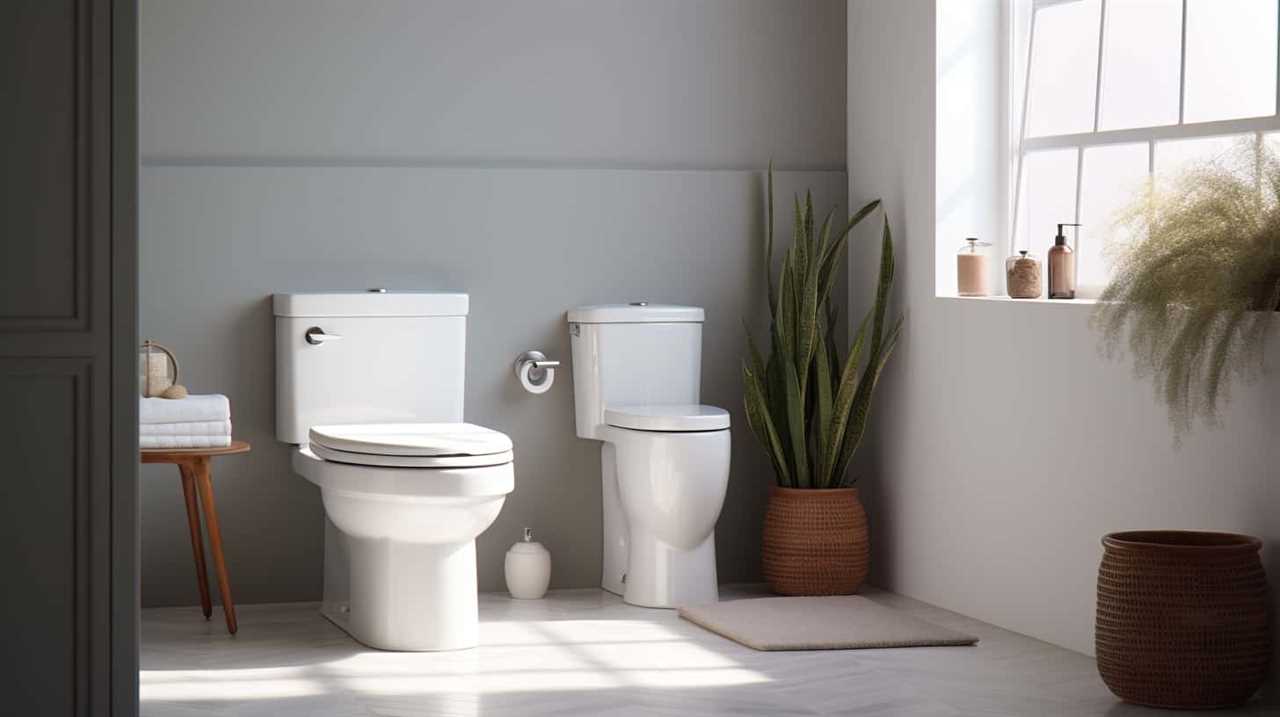
Arriving at the Sewage Treatment Plant
As the toilet paper makes its way through the plumbing system, it eventually arrives at the sewage treatment plant. Once it reaches the plant, the environmental impact of the toilet paper becomes an important consideration.
Many sewage treatment plants have implemented recycling options to minimize the amount of waste that ends up in landfills. Recycling toilet paper not only reduces environmental impact but also conserves resources by reusing the paper fibers.
However, the energy consumption of sewage treatment plant operations is another aspect to consider. Sewage treatment plants require significant energy to operate the various processes involved in treating wastewater, including the removal of contaminants and the disinfection of the water.
Balancing the environmental impact and energy consumption is crucial for the efficient and sustainable operation of sewage treatment plants.
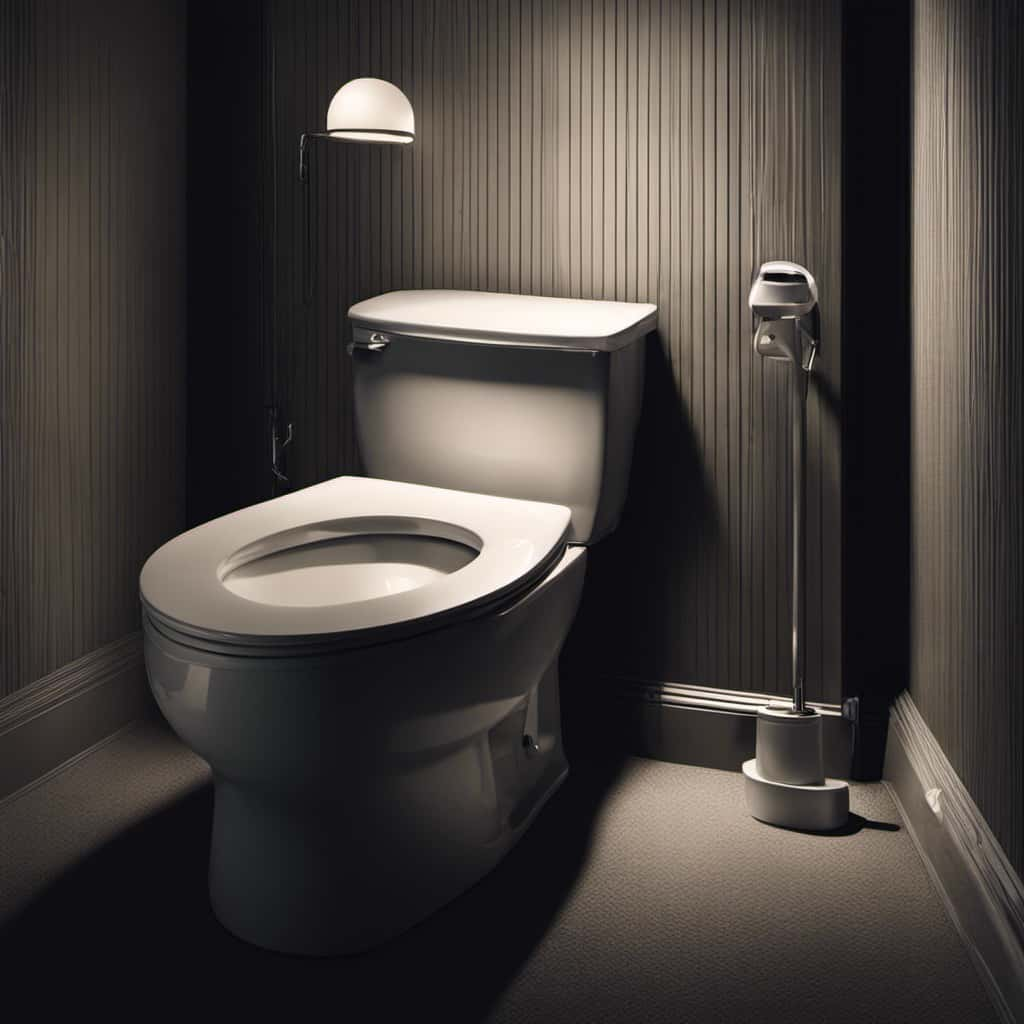
Now, let’s delve into the treatment process: breaking down toilet paper.
The Treatment Process: Breaking Down Toilet Paper
Once toilet paper arrives at the sewage treatment plant, it undergoes a process of breaking down into smaller fibers. This process is essential for the efficient treatment of wastewater. Toilet paper is designed to be biodegradable, meaning it can naturally decompose over time. However, during the treatment process, the biodegradability of toilet paper is accelerated through mechanical and biological means.
Mechanical processes involve shredding and grinding the toilet paper into smaller pieces, increasing its surface area for faster decomposition. Biological processes then take place, where microorganisms break down the toilet paper into simpler compounds.
While breaking down toilet paper is necessary for the treatment process, it’s important to consider the environmental impact. The increased biodegradability of toilet paper can lead to more organic matter in the wastewater, requiring additional treatment steps to remove solids effectively.
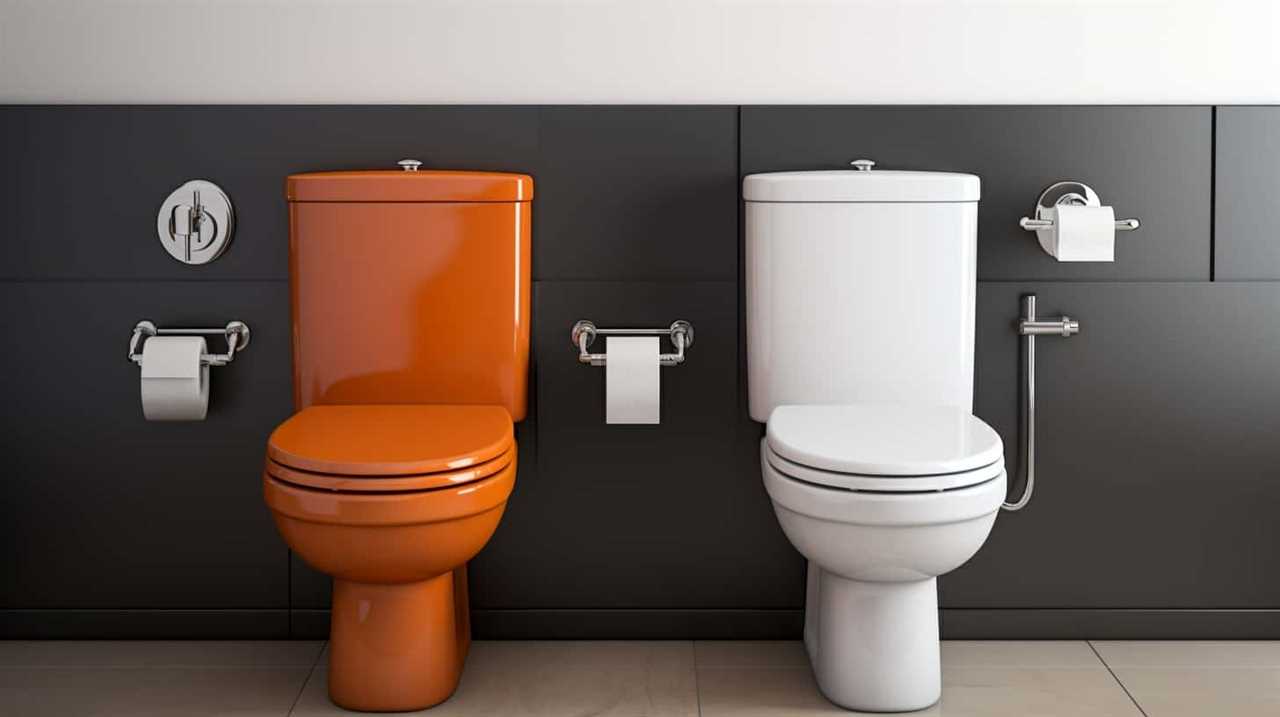
Transitioning into the next section, let’s explore how the treatment plant filters and removes these solids.
Filtering and Removing Solids
To ensure the efficient treatment of wastewater, the sewage treatment plant employs a process of filtering and removing solids, which builds upon the previous step of breaking down toilet paper.
After the toilet paper has been broken down, the remaining mixture of water and solids enters the next stage of the treatment process. This stage involves the use of screens, filters, and settling tanks to separate and remove any remaining solids from the wastewater.
The screens and filters catch larger particles, such as debris and non-biodegradable materials, while the settling tanks allow the smaller particles to settle at the bottom.

Once the solids have been effectively removed, the clarified water can continue through the treatment process.
It’s important to note that in certain systems, such as septic tanks or composting toilets, the process of filtering and removing solids may differ slightly.
The Final Destination: Disposal or Reuse
After the wastewater has been treated and the solids removed, we determine the final destination for the toilet paper: whether it will be disposed of or reused.
When evaluating the environmental impact of toilet paper disposal, it’s important to consider the sustainability of different methods. Traditional disposal methods, such as landfilling, can have negative effects on the environment due to the production of methane gas and the potential for contamination of soil and water sources.

Alternative solutions are being explored to reduce toilet paper waste and promote sustainability. One option is composting, which allows toilet paper to break down naturally and be used as nutrient-rich soil. Another option is recycling, where toilet paper can be transformed into new products.
Frequently Asked Questions
What Happens to Toilet Paper if It Doesn’t Break Down in the Sewage Treatment Plant?
If toilet paper doesn’t break down in the sewage treatment plant, it can end up in landfills or waterways. This can have a negative environmental impact. Proper toilet paper recycling is crucial to reduce waste and protect the environment.
Can Toilet Paper Clog the Plumbing System if Too Much Is Flushed at Once?
When too much toilet paper is flushed at once, it can definitely clog the plumbing system. To reduce clogs, consider using toilet paper alternatives. Excessive toilet paper usage and disposal can have negative environmental impacts.
Is Toilet Paper the Only Type of Material That Goes Through the Sewage Treatment Process?
There are alternative materials commonly flushed and processed in sewage treatment. Flushing non-biodegradable materials, besides toilet paper, can have potential environmental consequences.

How Long Does It Take for Toilet Paper to Decompose Once It Reaches the Final Disposal Site?
Toilet paper decomposes at different rates depending on various factors such as moisture, temperature, and the presence of oxygen. Its decomposition rate can range from a few weeks to several months. This process significantly reduces its environmental impact.
Is There a Limit to the Amount of Toilet Paper That Can Be Treated and Processed at Sewage Treatment Plants?
There are limitations to the amount of toilet paper that can be processed at sewage treatment plants. Excessive usage can have a negative environmental impact, making it important to be mindful of our consumption.
Conclusion
In conclusion, after being flushed, toilet paper goes through a complex journey within the plumbing system.
It arrives at the sewage treatment plant where it undergoes a treatment process to break it down.
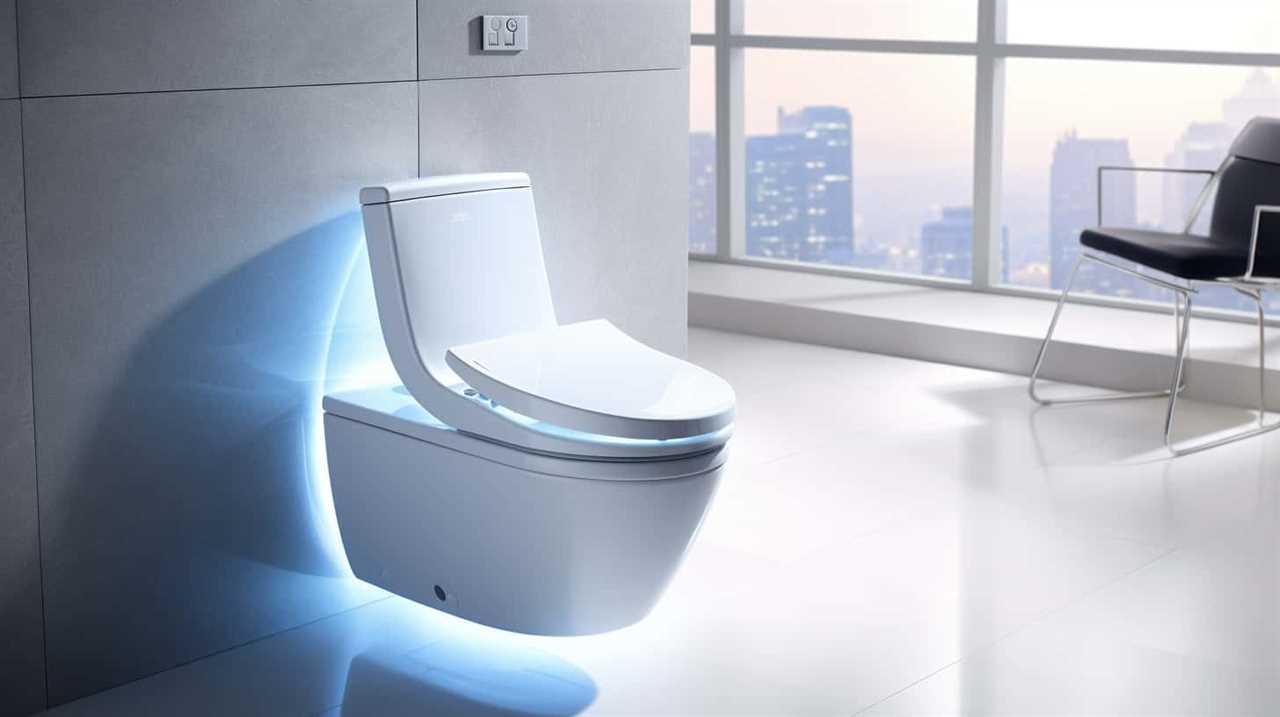
Solids are then filtered and removed, leaving the treated water ready for disposal or reuse.
This process ensures that toilet paper is properly managed and doesn’t cause environmental harm.
With an impeccable eye for detail and a passion for bathroom-related, Ava leads our editorial team gracefully and precisely.
Under her guidance, Best Modern Toilet has flourished as the go-to resource for modern bathroom enthusiasts. In her free time, you might find Ava exploring antique shops and looking for vintage bathroom fixtures to add to her collection.
Buying Guides
How Long Can a Toilet Go Without Flushing

Have you ever thought about how long a toilet can go without being flushed? We depend on our toilets to maintain proper hygiene every day, but failing to flush regularly can lead to some serious problems.
In this article, we will explore the factors that affect toilet flushing frequency, the potential risks of not flushing regularly, and the recommended flushing frequency for optimal cleanliness.
By understanding the importance of maintaining a well-functioning toilet, you can ensure a hygienic and efficient bathroom experience.
Key Takeaways
- Water quality affects the frequency of clogging in toilets.
- Regular maintenance is crucial for preventing clogs and ensuring effective toilet functioning.
- Factors such as the number of people using the toilet and the amount of waste produced determine the flushing frequency.
- Proper toilet cleaning and unclogging should be done regularly to prevent grime buildup and blockages.
Factors Affecting Toilet Flushing Frequency
To determine the factors affecting toilet flushing frequency, we need to consider the number of people using the toilet and the amount of waste produced.

Water conservation plays a crucial role in determining how often a toilet needs to be flushed. By minimizing the amount of water used per flush, we can reduce water wastage and contribute to overall conservation efforts.
Additionally, the impact on plumbing systems can’t be overlooked. Flushing too frequently can put unnecessary strain on the plumbing infrastructure, leading to potential issues such as clogs or leaks. It’s important to strike a balance between water conservation and maintaining the proper functioning of our plumbing systems.
Consequences of Not Flushing Regularly
Without regular flushing, toilets can quickly become breeding grounds for bacteria and unpleasant odors. Here are three consequences of not flushing regularly:
- Impact on water conservation: When toilets aren’t flushed regularly, water is wasted as it continuously fills the bowl. This not only increases water consumption but also puts a strain on the environment, especially in areas where water scarcity is a concern. Conserving water by flushing only when necessary helps in reducing our overall water footprint.
- Odor and hygiene concerns: Stagnant water left in the toilet bowl promotes the growth of bacteria and germs, leading to foul odors and potential health risks. Not flushing regularly allows these microorganisms to thrive, creating an unhygienic environment. The unpleasant smells can also permeate the surrounding area, making it uncomfortable for users and visitors alike.
- Plumbing issues: Neglecting to flush regularly can result in clogged pipes and drains. Solid waste and toilet paper can accumulate over time, causing blockages that require costly repairs. Regular flushing helps maintain proper water flow and prevents the buildup of debris, ensuring the proper functioning of the plumbing system.
Recommended Flushing Frequency for Optimal Hygiene
Maintaining optimal hygiene involves regularly flushing the toilet to prevent the buildup of bacteria and ensure a clean environment. To properly maintain your toilet and keep it free from harmful germs, it’s important to follow some toilet maintenance tips.

First and foremost, it’s recommended to flush the toilet immediately after each use. This helps to eliminate any bacteria or waste that may be present in the bowl. Additionally, it’s advisable to flush the toilet at least once a day, even if it hasn’t been used, to prevent any stagnant water from becoming a breeding ground for bacteria.
Regular flushing not only improves hygiene but also prevents unpleasant odors and keeps the toilet in good working condition.
Now that we understand the importance of regular flushing, let’s explore how long a toilet can go without flushing and the consequences that may arise from neglecting this vital maintenance task.
How Long Can a Toilet Go Without Flushing
Regularly flushing the toilet is essential for maintaining optimal hygiene and preventing the buildup of bacteria. But how long can a toilet go without being flushed? The answer depends on various factors. Here are three key considerations:
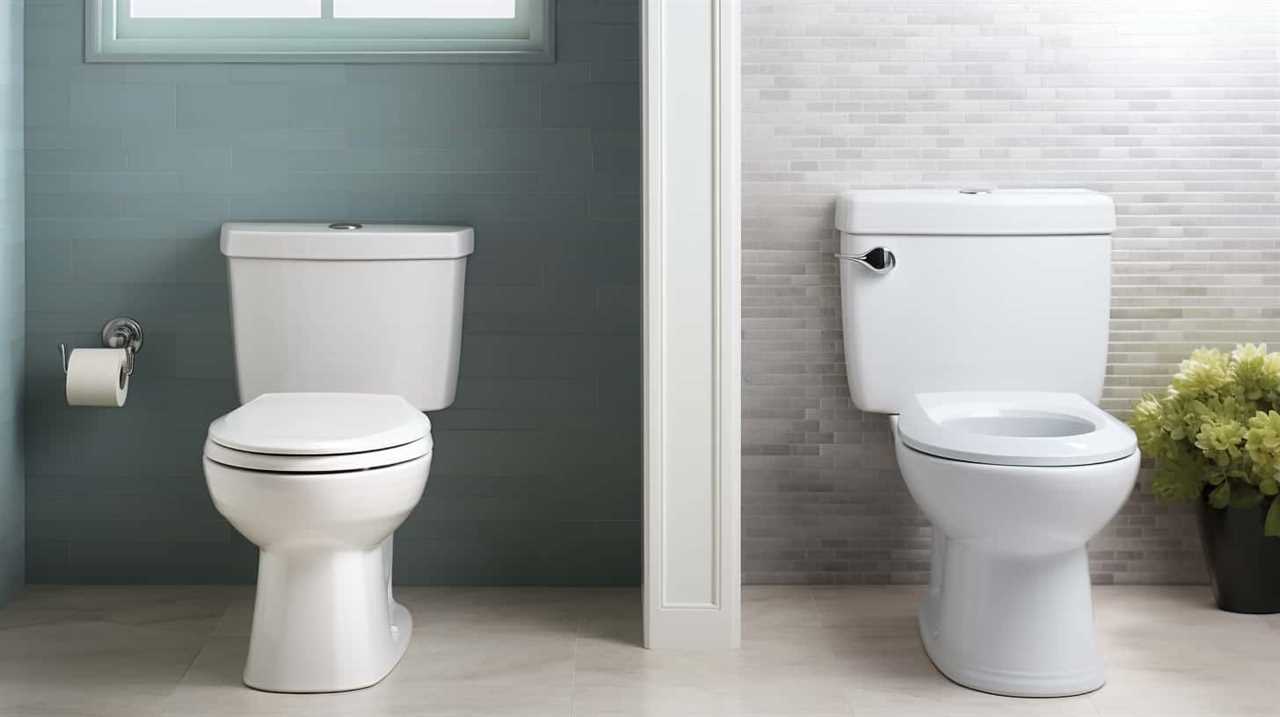
- Water quality: If the water supply contains high levels of minerals or impurities, it may lead to faster clogging and the need for more frequent flushing.
- Toilet usage: The more frequently a toilet is used, the shorter the duration it can go without flushing. Heavy usage can result in quicker accumulation of waste and bacteria.
- Toilet maintenance: Regular maintenance, such as cleaning and inspecting the toilet’s components, can help prevent clogs and ensure proper flushing.
Understanding these factors is crucial for effective toilet maintenance and water conservation. Now, let’s explore some tips for maintaining a well-functioning toilet.
Tips for Maintaining a Well-Functioning Toilet
To ensure a well-functioning toilet, we recommend regularly performing maintenance tasks.
Proper toilet cleaning is essential to prevent the buildup of grime and bacteria. Use a toilet brush and a mild cleaner to scrub the bowl thoroughly, paying attention to the rim and under the seat. Avoid using harsh chemicals that can damage the toilet’s components.
Additionally, regular unclogging of toilets is necessary to prevent blockages. If you notice the water draining slowly or hear gurgling sounds, it may indicate a clog. Use a plunger or a toilet auger to remove the obstruction. Remember to plunge gently and avoid using excessive force, as it can damage the toilet.

Frequently Asked Questions
Can a Toilet Go Without Flushing Indefinitely?
A toilet cannot go without flushing indefinitely as it would compromise toilet hygiene. Regular flushing is essential to remove waste and prevent bacterial growth. However, limiting unnecessary flushes can contribute to water conservation efforts.
Will Not Flushing the Toilet Regularly Cause Any Damage to the Plumbing System?
Not flushing the toilet regularly can have potential consequences on the plumbing system. It can lead to clogs, buildup of bacteria, and unpleasant odors. Additionally, it can also impact water usage, wasting valuable resources.
What Are the Potential Health Risks Associated With Not Flushing the Toilet Regularly?
Not flushing the toilet regularly can lead to potential contamination and bacterial growth. This poses health risks as pathogens can spread through fecal matter. Regular flushing is necessary to maintain hygiene and prevent infections.
Is There a Recommended Flushing Frequency for Public Restrooms?
There is a recommended flushing frequency for public restrooms. Regular flushing benefits hygiene and prevents odor and bacteria buildup. Following this frequency ensures a clean and pleasant restroom experience for all users.

Are There Any Alternative Methods or Products That Can Help Maintain a Clean Toilet Without Flushing as Frequently?
There are alternative methods and products to maintain a clean toilet without flushing as frequently. Toilet cleaning solutions and water-saving toilet options can help reduce the need for frequent flushing while still ensuring cleanliness.
Conclusion
In conclusion, neglecting to flush a toilet regularly can have serious consequences for hygiene and overall functionality. While the recommended flushing frequency varies depending on usage, it’s crucial to adhere to regular flushing to prevent the buildup of bacteria and unpleasant odors.
So, how long can a toilet go without flushing? The suspense builds as we reveal that it’s best not to test the limits and to maintain a well-functioning toilet by flushing regularly.
With an impeccable eye for detail and a passion for bathroom-related, Ava leads our editorial team gracefully and precisely.
Under her guidance, Best Modern Toilet has flourished as the go-to resource for modern bathroom enthusiasts. In her free time, you might find Ava exploring antique shops and looking for vintage bathroom fixtures to add to her collection.
-

 Bathroom Enhancements2 months ago
Bathroom Enhancements2 months agoWill Hot Bath Lower Blood Pressure
-

 FAQ - Advanced Bathroom Queries3 months ago
FAQ - Advanced Bathroom Queries3 months agoWhich Countries Use Bidets the Most
-

 Reviews1 month ago
Reviews1 month agoLDian Smart Toilet Review [2024]
-

 Reviews2 months ago
Reviews2 months agoKohler Innate Smart Toilet Review [2024]
-

 Reviews2 months ago
Reviews2 months agoKohler NUMI 2.0 Smart Toilet Review [2024]
-

 Reviews2 months ago
Reviews2 months agoCANEST Smart Toilet Review: The Ultimate Bathroom Upgrade [2024]
-

 Toilet Types3 months ago
Toilet Types3 months agoAre Bleach Tablets Bad for Your Toilet
-

 Reviews2 months ago
Reviews2 months agoWoodbridge B0970S Smart Bidet Toilet Review [2024]























